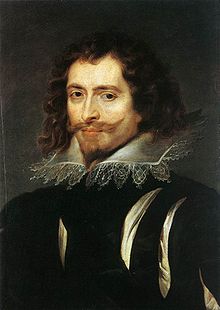- Duke of Buckingham
-
The titles Marquess and Duke of Buckingham, referring to Buckingham, have been created several times in the peerages of England, Great Britain, and the United Kingdom. There have also been Earls of Buckingham.
1444 creation
On 14 September 1444, Humphrey Stafford, 6th Earl of Stafford, was created Duke of Buckingham. He was the son of Anne of Gloucester, "Countess of Buckingham", daughter of Thomas of Woodstock, Earl of Buckingham (later Duke of Gloucester), youngest son of King Edward III of England. Stafford was an important supporter of the House of Lancaster in the Wars of the Roses, and was killed at the Battle of Northampton in July 1460.
He was succeeded by his grandson, Henry Stafford, 2nd Duke of Buckingham, who aided Richard III in his claiming the throne in 1483 (Edward IV of England's marriage to Elizabeth Woodville having been declared null and void and Edward's sons illegitimate by Act of Parliament Titulus Regius), but who then led a revolt against Richard and was executed later that same year.
His son, Edward Stafford, 3rd Duke of Buckingham, was restored to the title upon Henry VII's accession to the throne in 1485, but he was ultimately executed for treason in 1521 due to his opposition to Cardinal Thomas Wolsey, Henry VIII's chief advisor. At this time the title became extinct.
The Stafford family descended from Edmond de Stafford, who was summoned to Parliament as Lord Stafford in 1299. The second Baron was created Earl of Stafford in 1351. These titles were forfeited along with the dukedom.
1623 creation
The Dukedom was created anew for James I's favourite, George Villiers. He was made Baron Whaddon, of Whaddon in the County of Buckingham, and Viscount Villiers in 1616, Earl of Buckingham in 1617, Marquess of Buckingham in 1618 and Earl of Coventry and Duke of Buckingham in 1623. Buckingham, who continued in office as chief minister into the reign of James's son, Charles I, was responsible for a policy of war against Spain and France, and was assassinated by a Puritan fanatic, John Felton, in 1628 as he prepared an expedition to relieve the Huguenots of La Rochelle.
His son, George Villiers, 2nd Duke of Buckingham, was a notable advisor in the reign of Charles II, and, along with Lord Ashley made up the Protestant axis of the famous Cabal Ministry. He started the first foxhunt in England, The Bilsdale Hunt in 1668 and later started the Sinnington Hunt in 1680. He died from a chill after digging for a fox above Kirkbymoorside in the house of a tenant as he was too far from his home in Helmsley, North Yorkshire. At his death in 1687, the title again became extinct.
Several other members of the Villiers family have been elevated to the peerage. Christopher Villiers, 1st Earl of Anglesey, and John Villiers, 1st Viscount Purbeck, were brothers of the first Duke of Buckingham. Also, Edward Villiers, 1st Earl of Jersey, was the great-nephew of the first Duke of Buckingham while Thomas Villiers, 1st Earl of Clarendon, was the second son of the second Earl of Jersey.
1703 creation
The title of Duke of Buckingham and Normanby was created in 1703 for John Sheffield, Marquess of Normanby, a notable Tory politician of the late Stuart period, who served under Queen Anne as Lord Privy Seal and Lord President of the Council. For more information on this title, see the Duke of Buckingham and Normanby.
1822 creation
In 1784, George Nugent Temple Grenville, 3rd Earl Temple, a son of Prime Minister George Grenville, was created Marquess of Buckingham in the peerage of Great Britain. He served as Lord-Lieutenant of Ireland, among other offices. His son, Richard Nugent Temple Grenville was created Duke of Buckingham and Chandos in 1822. For more information on these titles, see the Viscount Cobham.
Barons Stafford (1299)
- Edmund de Stafford, 1st Baron Stafford (d. 1308), father of the 2nd Baron
- Ralph Stafford, 2nd Baron Stafford (1301–1372), created Earl of Stafford in 1351
Earls of Stafford (1351)
- Ralph Stafford, 1st Earl of Stafford (1301–1372) was a notable soldier in the Hundred Years' War
- Hugh de Stafford, 2nd Earl of Stafford (c. 1342–1386), eldest son of the 1st Earl
- Thomas Stafford, 3rd Earl of Stafford (c. 1368–1392), second son of the 2nd Earl
- William Stafford, 4th Earl of Stafford (1375–1395), third son of the 2nd Earl
- Edmund Stafford, 5th Earl of Stafford (1378–1403), fifth son of the 2nd Earl
- Humphrey Stafford, 6th Earl of Stafford (1402–1460), created Duke of Buckingham in 1444
Dukes of Buckingham, first Creation (1444)
- Humphrey Stafford, 1st Duke of Buckingham (1402–1460), eldest son of the 5th Earl
-
- Humphrey Stafford, Earl of Stafford (1425–1458), eldest son of the 1st Duke, predeceased his father
- Henry Stafford, 2nd Duke of Buckingham (1455–1483), only son of Lord Stafford, was attainted for treason in 1483
- Edward Stafford, 3rd Duke of Buckingham (1477–1521), eldest son of the 2nd Duke, was restored to his father's honours in 1485, but then executed for treason in 1521 and posthumously attainted in 1523
Dukes of Buckingham, second Creation (1623)
- George Villiers, 1st Duke of Buckingham (1592–1628) was a favourite of James I of England
- George Villiers, 2nd Duke of Buckingham (1628–1687), younger son of the 1st Duke, died without issue, and most of his titles went extinct
Dukes of Buckingham and Normanby (1703)
Dukes of Buckingham and Chandos (1822)
See also
Categories:- Dukedoms of England
- Dukes of Buckingham
- Extinct British dukedoms
- Villiers family
- Buckingham
Wikimedia Foundation. 2010.

